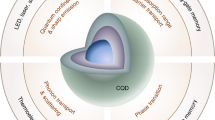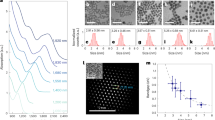Abstract
Solution-processed semiconductors are compatible with a range of substrates, which enables their direct integration with organic circuits1,2, microfluidics3,4, optical circuitry1,5 and commercial microelectronics. Ultrasensitive photodetectors based on solution-process colloidal quantum dots operating in both the visible and infrared have been demonstrated6,7, but these devices have poor response times (on the scale of seconds) to changes in illumination, and rapid-response devices based on a photodiode architecture suffer from low sensitivity8. Here, we show that the temporal response of these devices is determined by two components—electron drift, which is a fast process, and electron diffusion, which is a slow process. By building devices that exclude the diffusion component, we are able to demonstrate a >1,000-fold improvement in the sensitivity–bandwidth product of tuneable colloidal-quantum-dot photodiodes operating in the visible and infrared6,7,8.
This is a preview of subscription content, access via your institution
Access options
Subscribe to this journal
Receive 12 print issues and online access
$259.00 per year
only $21.58 per issue
Buy this article
- Purchase on Springer Link
- Instant access to full article PDF
Prices may be subject to local taxes which are calculated during checkout




Similar content being viewed by others
References
Xue, J. & Forrest, S. R. Organic optical bistable switch. Appl. Phys. Lett. 82, 136–138 (2003).
Kymissis, I., Sodini, C. G., Akinwande, A. I. & Bulovic, V. An organic semiconductor based process for photodetecting applications. 2004 IEDM Tech. Dig., 377–380 (2004).
Hofmann, O. et al. Thin-film organic photodiodes as integrated detectors for microscale chemiluminescence assays. Sens. Actuators B 106, 878–884 (2005).
Wang, X. Integrated thin-film polymer/fullerene photodetectors for on-chip microfluidic chemiluminescence detection. Lab. Chip 7, 58–63 (2007).
Morimune, T., Kajii, H. & Ohmori, Y. Semitransparent organic photodetectors utilizing sputter-deposited indium tin oxide for top contact electrode. Jpn J. Appl. Phys. 44, 2815–2817 (2005).
Konstantatos, G. et al. Ultrasensitive solution-cast quantum dot photodetectors. Nature 442, 180–183 (2006).
Konstantatos, G., Clifford, J. P., Levina, L. & Sargent, E. H. Sensitive solution-processed visible-wavelength photodetectors. Nature Photon. 1, 531–534 (2007).
Oertel, D. C., Bawendi, M. G., Arango, A. C. & Bulovic, V. Photodetectors based on treated CdSe quantum-dot films. Appl. Phys. Lett. 87, 2135051 (2005).
Wise, F. W. Lead salt quantum dots: the limit of strong quantum confinement. Acc. Chem. Res. 33, 773–780 (2000).
Jones, A. V. The infrared spectrum of the airglow. Space Science Rev. 15, 355–400 (1973).
Sargent, E. H. Infrared quantum dots. Adv. Mater. 17, 515–522 (2005).
Kim, S. et al. Near-infrared fluorescent type II quantum dots for sentinel lymph node mapping. Nature Biotechnol. 22, 93–97 (2004).
Jarosz, M. V., Porter, V. J., Fisher, B. R., Kastner, M. A. & Bawendi, M. G. Photoconductivity studies of treated CdSe quantum dot films exhibiting increased exciton ionization efficiency. Phys. Rev. B 70, 195327 (2004).
Luther, J. M. et al. Structural, optical and electrical properties of self-assembled films of PbSe nanocrystals treated with 1,2-ethanedithiol. ACS Nano 2, 271–280 (2008).
Talapin, D. V. & Murray, C. B. PbSe nanocrystal solids for n- and p-channel thin film field-effect transistors. Science 310, 86–89 (2005).
Clifford, J. P., Johnston, K. W., Levina, L. & Sargent, E. H. Schottky barriers to colloidal quantum dot films. Appl. Phys. Lett. 91, 2531171 (2007).
Acknowledgements
The authors thank D. Grozea for performing the XPS measurements.
Author information
Authors and Affiliations
Contributions
J.P.C conceived and fabricated the CQD photodiodes, performed all device performance characterization, and conceived and implemented the CQD photodiode device model. G.K. coordinated and interpreted the XPS measurements. K.W.J. and J.P.C co-developed the first step of the CQD surface modification strategy. S.H. and J.P.C. co-developed the second step of the CQD surface modification strategy. L.L. synthesized all CQDs used to fabricate the devices. E.H.S. assisted in interpretation of the results, commented on the device model, and commented on the manuscript. All authors discussed the results and the capacity of the model to describe the underlying physics of device operation.
Corresponding author
Supplementary information
Supplementary Information
Supplementary Information (PDF 295 kb)
Rights and permissions
About this article
Cite this article
Clifford, J., Konstantatos, G., Johnston, K. et al. Fast, sensitive and spectrally tuneable colloidal-quantum-dot photodetectors. Nature Nanotech 4, 40–44 (2009). https://doi.org/10.1038/nnano.2008.313
Received:
Accepted:
Published:
Issue Date:
DOI: https://doi.org/10.1038/nnano.2008.313
This article is cited by
-
Silver telluride colloidal quantum dot infrared photodetectors and image sensors
Nature Photonics (2024)
-
High-performance photodetector based on ReS2/WSe2/Te dual van der Waals heterojunctions
Journal of Materials Science (2024)
-
Flexible and broadband colloidal quantum dots photodiode array for pixel-level X-ray to near-infrared image fusion
Nature Communications (2023)
-
Ultrapure thin films of CdPbS and PbS and photodetectors based on them were obtained and studied for the first time
Indian Journal of Physics (2023)
-
Sub-millimetre light detection and ranging using perovskites
Nature Electronics (2022)



